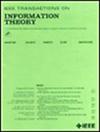New Bounds for Generalized Column Distances and Construction of Convolutional Codes
IF 2.2
3区 计算机科学
Q3 COMPUTER SCIENCE, INFORMATION SYSTEMS
引用次数: 0
Abstract
Based on known bounds for relative generalized Hamming weights of linear codes, we provide several new bounds for generalized column distances of convolutional codes, including the Griesmer-type bound for generalized column distances. Then we construct several infinite families of convolutional codes such that the (1, 1)-Griesmer defect of these convolutional codes is small compared with the length of these convolutional codes by using cyclic codes, negacyclic codes and GRS codes. In particular, we obtain some convolutional codes such that the (1, 1)-Griesmer defect of these convolutional codes is zero or one. Next we prove that the 2-generalized column distance sequence广义列距的新界限与卷积码的构建
基于已知的线性码的相对广义Hamming权的界,我们给出了卷积码的广义列距离的几个新的界,包括广义列距离的griesmer型界。然后利用循环码、负循环码和GRS码构造了几个无限族的卷积码,使得这些卷积码的(1,1)-Griesmer缺陷比这些卷积码的长度小。特别地,我们得到一些卷积码使得这些卷积码的(1,1)-Griesmer缺陷为0或1。接下来,我们证明了任意卷积码$\mathcal {C}$的2-广义列距离序列$\{d_{2,j}(\mathcal {C})\}_{j=1}^{\infty }$是递增的且有界的,并且该序列$\{d_{2,j}(\mathcal {C})\}_{j=1}^{\infty }$的极限与卷积码$\mathcal {C}$的2-广义Hamming权有关。对于$i\ge 3$,我们证明了任意卷积码$\mathcal {C}$的i-广义列距离序列$\{d_{i,j}(\mathcal {C})\}_{j=\lceil \frac {i}{k}-1\rceil }^{\infty }$是上下有界的。
本文章由计算机程序翻译,如有差异,请以英文原文为准。
求助全文
约1分钟内获得全文
求助全文
来源期刊

IEEE Transactions on Information Theory
工程技术-工程:电子与电气
CiteScore
5.70
自引率
20.00%
发文量
514
审稿时长
12 months
期刊介绍:
The IEEE Transactions on Information Theory is a journal that publishes theoretical and experimental papers concerned with the transmission, processing, and utilization of information. The boundaries of acceptable subject matter are intentionally not sharply delimited. Rather, it is hoped that as the focus of research activity changes, a flexible policy will permit this Transactions to follow suit. Current appropriate topics are best reflected by recent Tables of Contents; they are summarized in the titles of editorial areas that appear on the inside front cover.
 求助内容:
求助内容: 应助结果提醒方式:
应助结果提醒方式:


